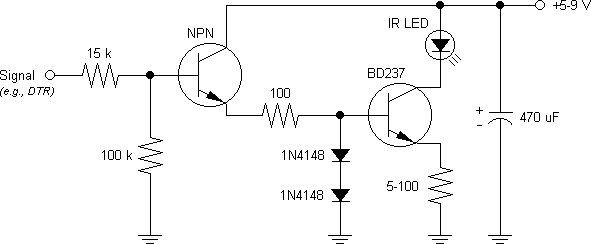

Serial Port Transmitters
|
The following text was taken from the lirc-0.3.6 package with kind permission of its author, Ralph Metzler. I have just substituted the ASCII arts by nicer GIFs (thanks to David Norris), recommend another IR LED (the LED recommended originally was transmitting at 880 nm which is not suitable for remote control applications which use 950 nm) and added a small signal diode to protect the IR LED from the voltage of the serial port. Most IR LEDs have reverse voltage ratings of only 5V. I received reports that the range of the first circuit will be much smaller if you use it together with an receiver. Sometimes it will even stop working at all. If you are looking for a circuit with better range and don't want to use an external power supply you should have a look at Enrique Vidal's circuit that he posted on the mailing list. I haven't tried it myself but it looks very promising. If you are looking for a ready-made transmitter solution you should have a look at the transceivers offered by www.irtrans.de. The transmitter part is quite powerful and the driver software provides a LIRC compatible socket interface. Simple transmitter circuit on serial port:  R should be greater than 1K so that the current is less than 10mA (my serial port has about +/- 10V). I guess it is also save to leave out the resistor since the serial port should also have a max. short circuit current. Since the maximum current is so small almost any infra-red LED should be usable The range of this device is up to 1m depending on the receiving device (e.g. with my Sony VCR) and if you aim right at the IR detector. Not good enough to be practical but enough to e.g. invent your own code to control your computer and program a programmable remote with it. Usage of the this circuit is not recommended if you value your serial port. If it is on the motherboard I would not use it! I use a serial port on a cheap serial card for testing. Actually I only say this, so that it's not my fault if your house burns down ... Does anybody know what can happen if you short circuit the serial port? If you don't want strain your serial port, use a bigger resistor or a simple amplifier circuit like this:  R in the amplifier circuit can be chosen as small as 5 Ohm (for 5V !). Since the signal is pulsed and with a 40kHz carrier frequency, an LED like the LD 271 (or others with max. 100 mA) can tolerate 1A for a short period of time. Some data sheets might mention how high the current can go for certain pulse lenghts. But take care that after the signal is sent the signal line is low or your LED might become a little "brownish" like one of mine did :-) (It even still works, but the range decreased to a few centimeters ...) It should be safe if you use >50 (>90) Ohm for 5 (9) V, but the range will be much smaller. Petteri Aimonen sent in the following suggestion to better protect the curcuit from overloading without significant loss of range. The trick is to add a 100nF - 220nF capacitor in parallel to the current limiting resistor which he suggests can be then as high as 50 Ohm:
+5V
|
_|_ -->
\ / --> IR LED
--- -->
BD237 |
|---'
--|
|->-o------------,
| |
| |50Ohm ----- 100nF-220nF
|_| -----
| |
o------------'
|
----- Earth
---
-
Another suggestion for a high-power LIRC transmitter/receiver comes from Brian Shucker. This design integrates both receiver and transmitter in one circuit using one power supply just ready to use. |